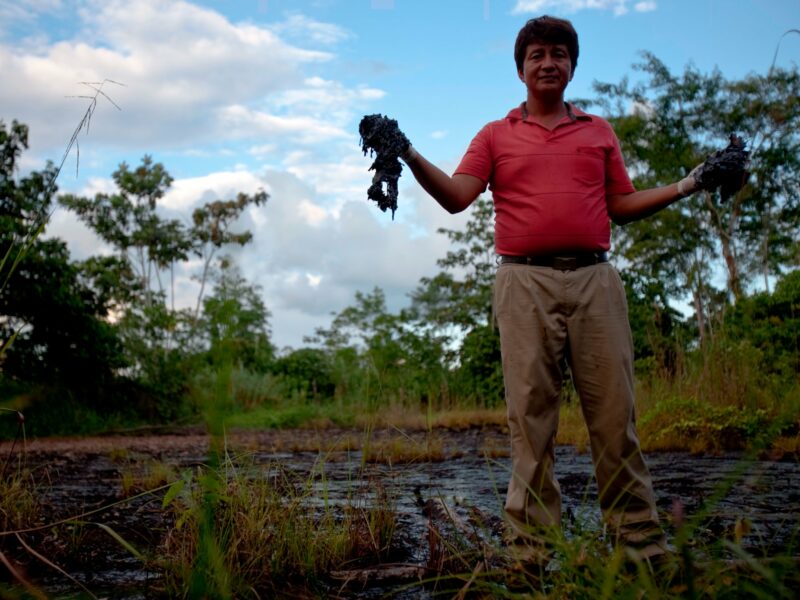I am standing in the Kichwa indigenous village of Rumipamba, breathing heavy air laden with the scent of oil, watching fathers, mothers, aunts work in the oppressive heat, cleaning up the crude that has been contaminating their ancestral lands for the last 40 years. The Kichwa hadn’t even been informed what was happening when Texaco (now Chevron) came to drill for oil on their land; they hadn’t been consulted when Texaco filled an unlined pit with crude and waste chemicals uphill from the village. When heavy tropical rains filled up the pit and the sides split sending crude spilling all through their waterways – no one came to clean it up. Forty years later the Ecuadorian government have given the people a machine which bubbles air though the mud and water, separating the crude and mud, then, they painstakingly scrape away the crude from the surface of the water, filling barrels as children play nearby.
Before 1964 when Texaco (now Chevron) discovered oil in the remote, pristine Northern Ecuadorian Amazon the rainforest was an area of “alpha diversity” meaning that scientists have since recognized this area as being one of the most biologically diverse in the world. The ancestral custodians of the forest the Cofán, Siona, Secoya, Kichwa and Waorani indigenous peoples, lived traditional lifestyles largely untouched by modern civilization. They hunted, fished, and their shaman (medicine men) used medicinal plants from the forest to cure all known illnesses, enjoying a rich spiritual and cultural life.
The cultures of indigenous people the world over are expressions of the ecosystems in which the cultures are embedded. The indigenous peoples language, food, music and governance are all informed by the vast rainforests in which they live. To the indigenous peoples of the Amazon the forest is their pharmacy, their hardware store, their grocery. Their profound and intimate knowledge is passed down and built upon over generations of observing and learning from Nature through experience. The rain forest is the source of wisdom, and life, humans are sustained by it, and are as much a part of the web of life as the mighty Kapok tree, Jaguar, Howler monkey or Pink dolphin.
As a child I dreamed of living with indigenous peoples in the Amazon. After studying Anthropology at Sydney University, and working with Amazon foundations I finally got my chance. I lived with the Achuar people in the South Central Ecuadorian Amazon and fell deeply in love with these warrior peoples, their worldviews, and way of life. They lived as their ancestors had done, with deep understanding of the interconnectedness of all life, be it human, flora or fauna.
When I first visited the area contaminated by TexacoChevron in the Northern Ecuadorian Amazon from 1964 to 1992 in my role as Amazon Watch Ambassador, I was not prepared to witness such destruction and contamination of the entire forest ecosystem. What has been called “an industrial cancer zone” affects an area nearly one and a half times the size of the ACT. After having lived in the remote pristine South Central Amazon region the contrast was even more heartbreaking as I listened to Cofan people speak of the idyllic paradise in which they lived until the oil company arrived.
Texaco was the first company to successfully drill for oil in Ecuador, being a world renowned company the government entrusted Texaco with pioneering and setting the standards for oil exploration in Ecuador. However, Texaco chose to save $3 per barrel of oil by using practices outlawed decades before in the US. Instead of re-injecting toxic “formation waters”, a bi-product of oil extraction back into the earth, as was customary in the Texaco’s home state of Texas since 1919, Texaco chose to put profits before people. Over its 28 years of operation Texaco dumped more than 18 billion gallons of toxic waters and waste crude directly into rivers and over 900 unlined toxic pits throughout the area impacting 30,000 indigenous people and farmers living in the area. These “formation waters” contained some of the most dangerous chemicals known to man including Policyclic Aromatic Hydrocarbons (PAH’s), benzene and toluene. One court-ordered technical report on file in Lago Agrio court house concludes that Texaco’s pollution caused 2,091 cases of cancer among residents and led to 1,401 deaths from 1985 to 1998.
An internal Texaco memo dated July 17, 1972, instructed employees in Ecuador to disclose “only major events.” The memo adds: “No reports are to be kept on a routine basis and all previous reports are to be removed from Field and Division Offices and destroyed.”
In 2001 Chevron bought Texaco and its toxic legacy, with full comprehension of Texaco’s liabilities, plaintiffs had already filed a case against Texaco in 1992 in the US Federal court. Chevron then fought to have the case moved from the US to Ecuador arguing that the countries court system was fair and transparent. It was only after Chevrons guilt became clear that the company started to attack Ecuador’s court system. Two Chevron officials, and seven former Ecuadorian government officials, are under criminal indictment in Ecuador for committing fraud during a purported remediation in the mid-1990s.
After eighteen years, a judgment was finally passed earlier this year – Chevron was found culpable and ordered to pay $US8.6 Billion to clean up. In addition the judge ordered Chevron to publically apologize to the plaintiffs, failure to do so would result in a doubling of the awarded amount. Chevron refused to apologize, and they are now liable for $18 Billion (which is only $1 for every gallon of poisonous waste dumped into the Amazon). But the battle for justice for the 30,000 people affected by the contamination is not over – now the issue is the enforcement of the ruling, as Chevron no longer has any assets in Ecuador. And the mighty economic power of Chevron has responded with preposterous countersuits filed against the plaintiffs and their attorneys in the US courts.
However, there have recently been some huge victories for the plaintiffs. A series of diplomatic cables released by Wikileaks, written by U.S. officials, show that Chevron engaged in a covert lobbying campaign aimed at getting the Ecuadorean government to intervene in the lawsuit.In September a US appeals court threw out an injunction by Chevron friendly Judge Kaplan that purported to prohibit the Ecuadorian plaintiffs from enforcing the $18 billion judgment against Chevron. It also indefinitely stayed a trial that Judge Kaplan had scheduled for November over the countersuit filed against the Ecuadorians and their attorneys.
Also New York State Comptroller Thomas DiNapoli, the trustee of the New York State’s Pension Fund with $780 million in Chevron stock demanded that “Chevron’s board of directors to settle this marathon litigation and spare the company’s battered reputation any further damage.”
I have visited the area affected many times over the last five years, but the deep sadness, disgust and shame I feel doesn’t subside. I, like all of us living in the western world live a life awash with oil. It is only recently that I have awakened to how this quest for oil has tragically impacted people, and the forest, the human rights issues that ensued often as a result of oil mining, and the contamination of precious ecosystems.
Let us not forget that Chevron is the largest holder of natural gas resources in Australia. The Gorgon Project – Liquefied natural gas (LNG) on Barrow island and the Wheatstone Project (LNG) in the Pilbara region of Western Australia are currently in development. As an Australian, I, for one am very interested in what Chevron chooses to do in Ecuador, not only for the future of the Amazon, but also for the future of our beloved sunburned land of Australia.
The courage and suffering of los affectados, the affected ones, never cease to inspire and humble. And I still see this as a time of great hope. More and more corporations are choosing to reconsider valuing short term profits at the expense of environmental protection and human rights. Chevron has a huge opportunity to accept responsibility, negotiate a fair settlement and do what is right for the Amazon, the plaintiffs, and its investors.














